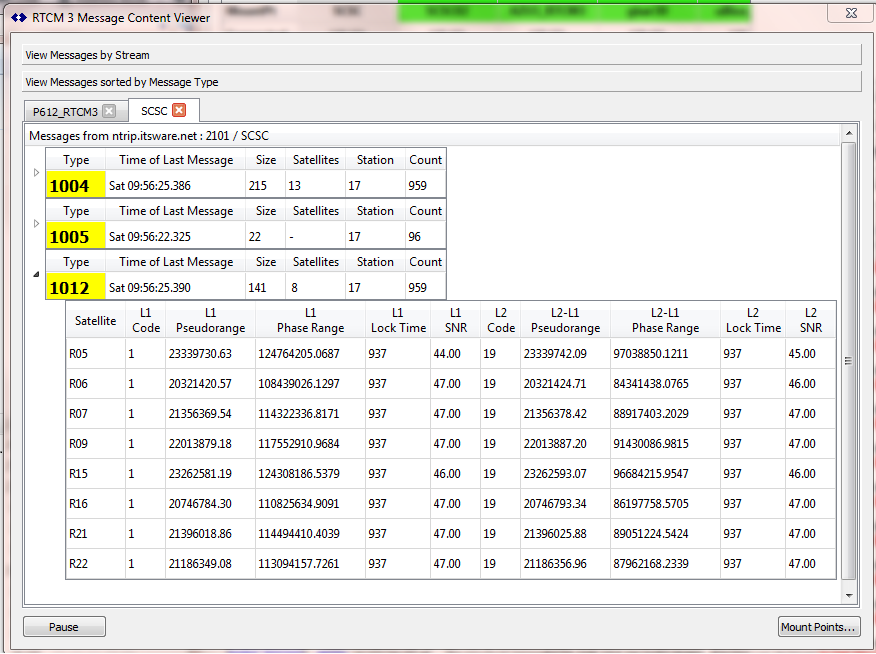Instructions for displaying the contents of RTCM observational data message types 1001~1004, and 1009~1012.
When something is not working in a GNSS navigation filter, it is often helpful to look at the raw observational data that is input to the filter. In the typical RTK filter there are are least two of these, the rover data stream and the base station data stream, (there may be more input sources such as orbital data and other corrections). When the base station data comes from a SNIP Caster, then the RTCM Content Viewer dialog can be used to look at the message contents.
Hint: There is no technical reason you cannot also send the rover data stream to SNIP as well. This allows decoding the data stream and logging it for replay. The RTCM Content Viewer dialog tabs are designed to provide side-by-side decoding and pause-run features to assist in this.
How To…
To enable RTCM3 decoding the selected stream must be parsed. And of course it must contain messages in an RTCM3 form (other content can also be present but will be ignored).
- On any stream’s display (for any stream type in a tab display)
right-click and be sure the Parse check box is active. - Select the Show in RTCM3 Viewer menu item to start the RTCM3 decoder dialog,
the dialog will appear with the selected stream in its own tab. - Click on the small arrows on the right side on any message type,
the view will be expanded to show the detailed contents of that message. - Resize the display window as needed when many items are expanded.
In order to see the last (most current) message of a given type, switch to the “View Messages sorted by Message Type” mode. The dialog display starts in this mode, but may be in the “View Messages by Stream” mode if it was used before. As new messages arrive, the data shown in each tab will be updated. You can also stop the display from updating with the Pause button at the bottom of the dialog.
If the menu item Show in RTCM3 Viewer menu item is greyed out, re-confirm that the Parse menu item is checked. If the dialog appears but no data is shown, then no RTCM3 message content has been found in the stream to decode.
Hint: Rather than invoke this dialog with its more detailed decoding, if you are simply interested to learn if a message type exists in the data stream; just use the Show Message Types menu item. If the stream is being parsed, a precise listing of the messages that are decoded will be sent to the console as they occur. If the stream is not parsed, then SNIP‘s universal decoder will provide a rough summary of the data contents it can decode. Be sure to uncheck this menu item when done, as it causes a considerable amount of console log clutter.
This is quick way to discover if a Base Station is sending in proprietary messages, rather then the RTCM3 you thought. It is also useful to discover that a station is sending in unwanted NMEA-183 message content (which would be corrected not in SNIP but by proper setup of the base station). [When SNIP is Parsing a stream for RTCM3 content, such extraneous content is filtered out and is not sent to the NTRIP Clients.]
Typical Data Content
Here is a typical display for a stream called “P612_RTCM3” which happens to be sending GPS data from a Trimble NetR9 device. Click image for full size.
It is evident from the above that the 1004 message is sent at about a 5x rate more often than the other messages (1Hz versus every 5th second). Looking at this one sample; the SVs appear to have reasonable SNRs for both L1 and L2 data and it has been over 15 minutes since the last cycle slip (loss of lock) was observed on any SV. No orbital data is present, nor is there any GLONASS data. And the private message type 4094 is also present in the stream.
Note: The count values shown in the above are active from the time the window is started, not from the time the Base Station data stream was started. The time stamp is expressed in the user’s local time zone and based on his PC clock. The satellite SV numbering uses the common first letter abbreviations (G=GPS, R=GLONASS, S=SBAS).
For GLONASS Messages
The above example used a type 1004 stream which contains GPS data. The similar message types for GLONASS are 1009 to 1012. And like the GPS case for message 1004, the 1012 message is found much more often than any of the others.
The process for displaying this type of data is precisely the same as above. If there is any GLONASS data present, it will be shown. When nothing is displayed, it indicates there is no GLONASS data in the stream. Here is an example of a typical base station sending both GPS and GLONASS data streams. The GLONASS raw observation message 1012 is shown in it’s expanded view. Click image for full size.
See Also
These articles contain similar information about decoding other common RTCM message types
Viewing RTCM 1019 and 1020 messages
Using the RTCM3 Decoder Dialog


